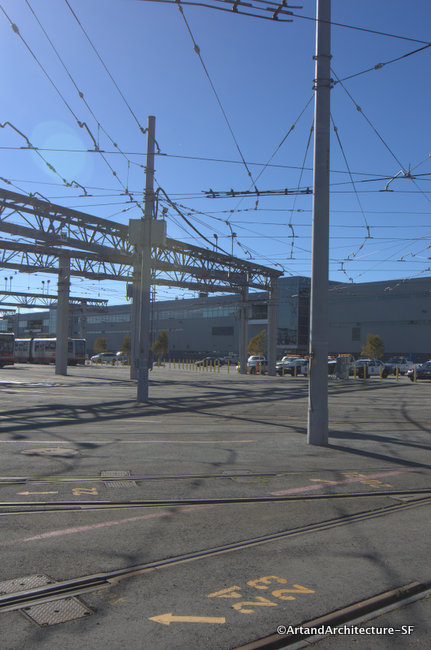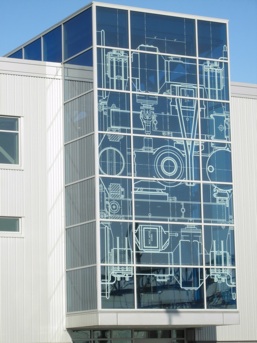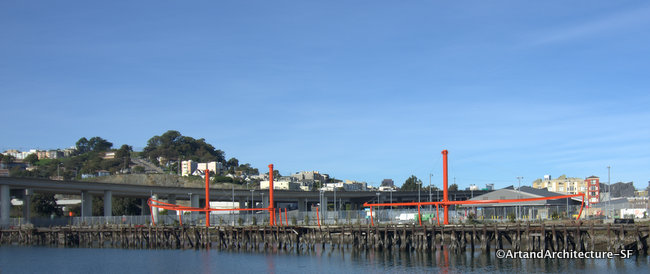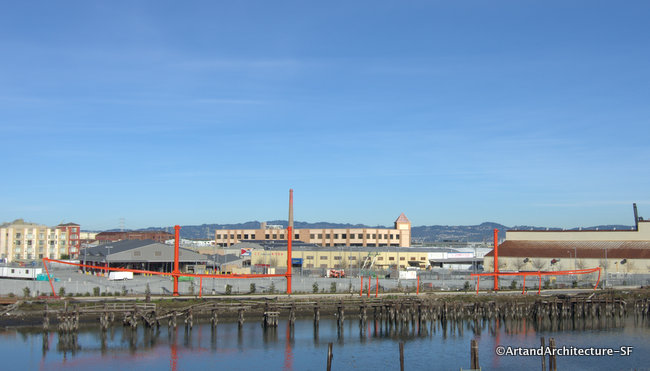Muni Metro East Yard
Pier 80
Bayview
This view, taken through a fence, is as close as one will get to the art work at the new Muni Metro East maintenance facility.
These photos I took from the Pulp Studios website.
I am going to simply copy directly what they have to say about these pieces as the information is excellent.
“The beauty of rail car engineering details is revealed in these historic blueprints from the 19th and 20th centuries.” Artist Anita Margrill’s statement rings true upon the very first site of the two towering glass curtain walls on the Metro East Light Rail Vehicle Maintenance and Operations Facility. This installation is a prime example of how art can seamlessly meld with Architecture, while taking two very standard stairwells from ordinary to extraordinary.
The artists Nobuho Nagasawa and Anita Margrill were inspired by the intricate pattern of white lines contrasting with the bold blue on the engineering blueprints they had found in the Muni Metro Archives.
In 1996 Pulp Studio received the call from Judy Moran of the San Francisco Arts Commission to work with artists to fabricate these two very large curtain walls, that measure an impressive 36 feet high by 19 feet wide. At the time Pulp proposed bringing the vision into reality by carving the line portions onto the glass and then painting them white to capture the vibrancy of the bold white lines of the drawing. However, this being a public works project 10 years had passed by the the time the facility was ready for it’s crown jewels to be produced.
During the interim, better technologies were formed and Pulp Studio recommended using their photographic laminated SentryGlas Expressions (SGX) product instead of the carved glass. SGX is a form of laminate that can be printed on in the full RGB spectrum, and even in white to produce photographic quality images. Once laminated the unprinted areas are clear, this product is what allows the blueprints to have their highly defined intricate bold look.
The 21 individual insulated glass sections of each curtain wall are comprised of two parts. A laminated blue glass panel on the interior and a clear glass panel on the exterior laminated with a mechanical engineering drawing printed in white on SGX as the substrate within the glass.
The San Francisco Municipal Transportation Agency recently won an award for the facility from the American Public Works Association, which is a national association that recognizes exceptional public works projects. This facility won in the category of projects costing over $75,000,000. Judy Moran of the SFAC said, “I am sure the curtain walls played a large part in making it an exceptional facility. Everyone is very happy with them, they are stunning.”
These pieces were commissioned for $100,000.
Nobuho Nagasawa has appeared here before with her Liberty Ship sculpture at the SFMTA Motor Coach Facility.
Anita Margrill was born in New York City . She attended Cranbrook Academy of Art, received her BA from Bennington College, her B. Architecture from CUNY School of Architecture and Environmental Studies, and her MA in Interdisciplinary Arts from San Francisco State University. As a licensed architect she has designed and built several passive solar houses and she holds numerous copyrights and patents for her water distribution systems.




